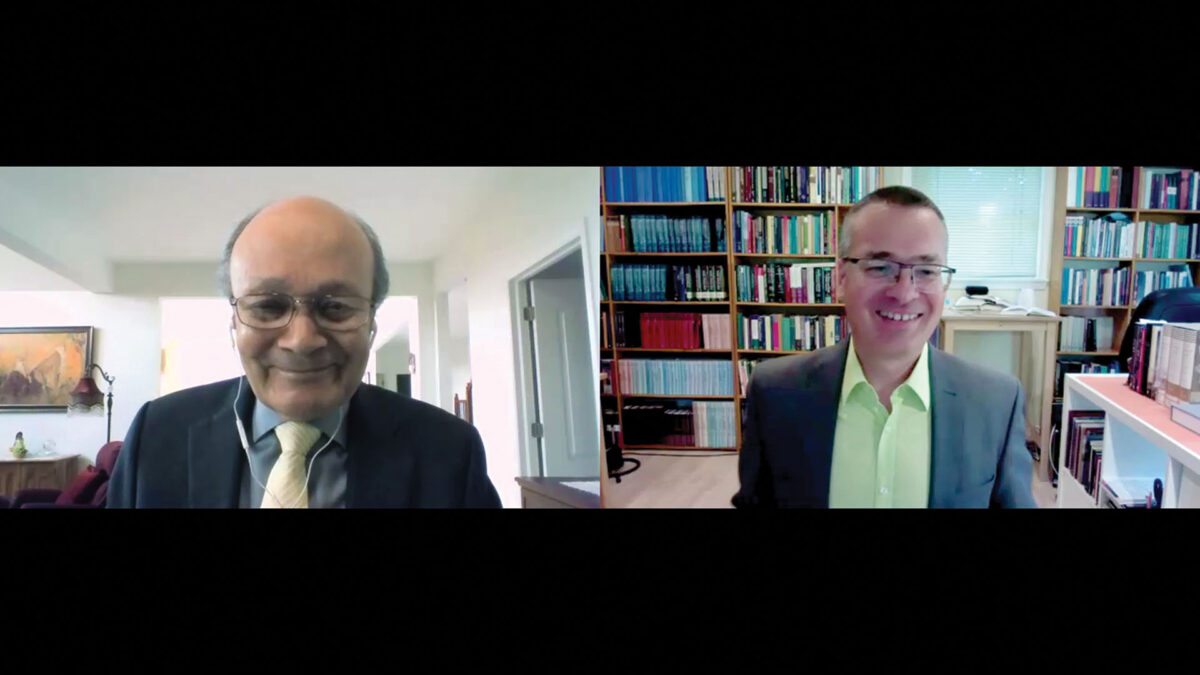A conversation about the three angels’ messages

Adventist World associate editor Gerald Klingbeil spoke with Ángel Manuel Rodríguez, former director of the Biblical Research Institute, via Zoom about the content, significance, relevance, and timeliness of the three angels’ messages within the larger context of Adventist theology.
Adventists are very familiar with the phrase “three angels’ messages,” while other Christians may wonder what this phrase means. What does this phrase refer to, and why is it important?
For Adventists this phrase is very significant, because our roots are found in apocalyptic prophecy. Other Christians, who perhaps are not that well informed about apocalyptic prophecies, may be disoriented when they hear the three angels’ messages terminology.
But for us the three angels’ messages, located in Revelation 14:6-12, are an important and significant passage containing God’s last message for the human race.
There is a renewed emphasis on the three angels’ messages. Are we doing something that we’ve never done before? Why is this focus so important right now?
It’s good to reread the Bible. By going back, we possibly encounter new insights and find new ways of expressing the same truth.
We go back to our passage to keep it fresh in our collective mind as a church. The significance of the three angels’ messages is such that we need to be almost constantly speaking about this. Otherwise it will lose its significance.
You see, we are pilgrims sharing what we have with others. We cannot allow ourselves to leave by the side of the road this important part of our message and life. Let’s talk about it as often as possible.
If we look at Adventist theology as a whole, where would you locate the three angels’ messages in terms of importance?
The three angels’ messages are part of the teachings of the church, and these teachings are wholistic. It’s one entity, making it difficult to assign some to the periphery. We do believe that at the center of Adventist doctrine and theological thinking is Jesus. There’s no other way.
Through the study of biblical doctrines, we gain new insights in terms of who Jesus is, and what His plan is for us. When you look at Revelation 14:6-12, you notice that many of our doctrines are directly or indirectly present in it.
You take the beginning, verse 6, and the first thing the text says is that the angel is proclaiming the gospel. We’re talking about the heart of the matter here. This is the center of the three angels’ messages, placed at the very beginning of the passage. This is going to orient the rest of the passage.
Is that a different gospel than Jesus preached, or the apostles, or anybody since?
The fact that it’s called the eternal gospel is telling you really that this gospel was, if I may say so, conceptualized in the mind of God in eternity. It’s what God also calls the “great mystery” that was hidden for ages and ages and has now been revealed to us through Jesus.
This gospel was in God’s mind, and He wants to implant it in our minds and lives. It’s eternal because it has always been His plan for us. This one gospel is eternal, unchangeable, and always relevant.
Could you give us a one-sentence summary of each of the messages of the three angels? What would be the key concept for each message?
The Lord invites every person, when confronted by the gospel of salvation, to fear God, to make God their covenant Lord, to give Him glory, to repent and recognize Him as a righteous judge, and to worship Him as Creator in a world of apostasy, secularism, and atheism.
The second message is also good news, because it’s about the fall of the enemy. The Babylon that is fallen is the unification of political and religious powers that are in opposition to God.
The last message is a wonderful message as well. It’s God’s heart opening up to us, saying, “Choose Me, choose Me, because if you become loyal to the forces of evil, what you will experience is eternal death, so don’t do that.” The language is strong , because we are standing, so to say, at the edge of the abyss, and God is shouting , “Don’t take another step! Come back!”
Ángel, I think you must’ve also been an evangelist.
Pastors are [smiles].
Starting with the Millerites, our spiritual forebears, and early Adventists, we have preached the three angels’ messages for more than 175 years. Has our preaching changed?
The three angels’ messages were read by Christians before we did it. Some applied them to the work of Luther or Calvin. The Millerites applied them to their own experience. Through the study of the Scriptures the pioneers found in this message their own identity, their own mission. These have remained an integral part of our message and mission to the world.
So you would say that we are standing in the same tradition? that we’re preaching the same message that these early Adventists were preaching?
No question about that.
Adventists, similar to other Christian denominations, struggle to engage young adults who often leave the church when they transition after finishing high school or college. How can we best communicate this important element of Adventist theology to this generation?
This is a complex question, but I will go back to the concept that we began with. We need to talk about the three angels’ messages. We have to bring it to the attention of young people, not once, but constantly, as often as possible. Make them aware of the content and significance of this message. I would also suggest that we present the topic as part of a cosmic conflict.
If there is something that I believe that humans, and particularly young people, can understand, it’s stories. We all love stories. Now we have the most wonderful story to tell. Perhaps one of the problems is that we have taken that story and have broken it apart into what we call doctrines.
In some cases we have not been able to put them together as a narrative, as a story. It seems to me that if we would develop a way to tell the whole story to young people, they would be taken by it. Show them that the three angels’ messages are part of the cosmic conflict. Challenge them and tell them, “This is a magnificent story, a true story. You have a part to play in it. You are an actor in this story.”
I believe that if the story is told with energy, enthusiasm, and consistency, young people will say, “Wow, this is amazing!” The story of the cosmic conflict answers for them the question of existential significance: what are we doing here?
Narratives and stories work in many different cultures. “Relevance” is another key word. For this generation, and for most of us, if something is irrelevant, we tend to ignore it. Can you help us frame the relevance of the three angels’ messages for the twenty-first century?
I can mention only a few things. I suppose “relevant” means meaningful. So it means that I somehow have to talk with young people to identify their real needs. They have their own perceived needs, but there are needs that go deep inside every human being. It would then be our task to show how the three angels’ messages best meet their real personal needs.
The question Why am I here? is a question that many young people don’t ask. They know only that they are here now. Why are we here? is a big question that the three angels’ messages help to answer.
We have to also place it in the context in which they live, which is, particularly in the Western Hemisphere, a secular world. Where is God within this intellectual map?
The three angels’ messages tell you where He is. I’m here. I’m the Creator. You are breathing every second of your life because of Him. It means if God withholds the breath, we die.
This message is powerful when connected, as it is, with the concept and the experience of hope. When people are disoriented, they need something to hold on to that will give meaning to their lives. It has to begin with talking to them, opening our hearts to them as we lovingly tell them the most glorious story of cosmic love flowing from the heart of God to ours.
I like your notion that hope is such an important element, and that there is a yearning in our souls. It’s not just young people. I think it’s you and me.
Everybody.
If you look at our world right now, we need more hope. Are the three angels’ messages really a message of hope?
Definitely. If you look for the source of hope, where was hope born? Look, it’s almost the first word in the message, the “everlasting gospel.” If we go back to the Fall, there was no future for humans, but then the gospel came and filled their hearts with hope. This hope is at the center of the message.
They [the three angels’ messages] introduce the hope of salvation already realized in the work of Christ proclaimed in the gospel. The message points to the consummation of hope in the second coming of Christ. For now, this hope is ours in the form of a promise, but it will soon become a palpable reality.
How do the three angels’ messages fit into the overall picture of Adventist theology?
How do we do theology? You need a starting point. Of course, you start from the Bible, but you go to the Bible and you pull from it God’s message for us. Adventists went to the Bible. They gathered together these wonderful jewels. And they understood that these jewels were to be proclaimed at the close of the cosmic conflict.
It provided for them, and for us, a point of reference. There are two integrating key elements in Adventist theology.
The first one is the doctrine of the [heavenly] sanctuary. There’s no question that the doctrine of the sanctuary is extremely important in the Bible, because it’s about Jesus, His nature, His role, His death on the cross, and His ministry as mediator. If that is not going to integrate our system of beliefs, what else can do it?
The second element that I would suggest is the three angels’ messages. These messages, together with the sanctuary, bind the elements into a message for the last days that is framed, so to speak, by the cosmic conflict. Now, if I’m going to do theology as an Adventist theologian, this is the Adventist perspective. I have to take these elements with me in my theological journey.
Ángel, thank you for this conversation. Thank you for your passion. Thank you for your evangelistic drive.
My pleasure. Thank you for the invitation.
A video of the longer version of the interview can be seen at vimeo.com/454016252








